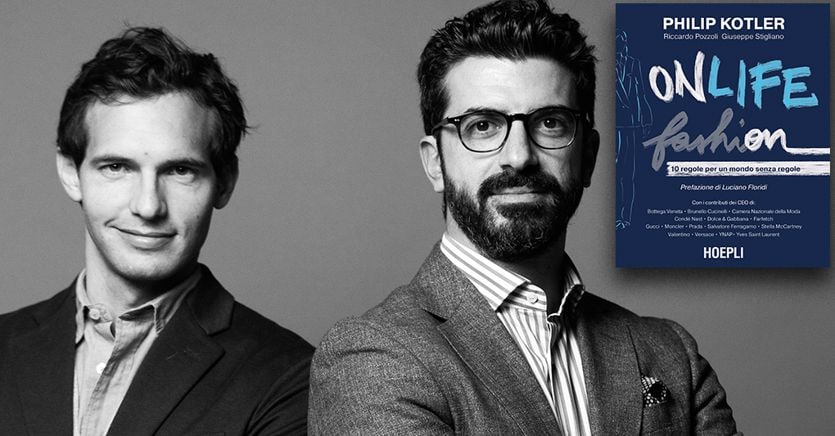Years ago, before the revolution brought about by the internet, someone proposed to establish a world day of dialogue between generations, imagining the youngest listening attentively to the stories of life and work of those who preceded them. Perhaps even more useful would be a day dedicated to true dialogue, to the exchange of points of view, as well as passive listening. Of course, there must be the will to embrace the new on the part of those who come from afar and respect on the part of those born in a different, much more recent reality. This alchemy was managed by Philip Kotler, Riccardo Pozzoli and Giuseppe Stigliano (in the photo) and the book was born. Onlife fashion. 10 rules for a market without rules, published by Hoepli , which will be available, in bookstores and e-book format, from 9 April.
The fashion industry as a starting point
It is focused on fashion, but, as the choice of the adjective onlife says (it is not a typo!) It suggests reflections and draws conclusions that can be valid for many other sectors. The digital revolution is part of a world already profoundly transformed by globalization. Indeed, it is perhaps a necessary evolution: the Internet, however, has not only changed the economic processes and geopolitical balances between countries, has upset the lives of all of us consumers, as well as that of companies of all sizes. «Working with Kotler was a surprise and at the same time a dream come true – explain Pozzoli and Stigliano almost in unison -. He is the greatest marketing expert of all time and has written over 60 books, but his observations and reflections could be those of an enlightened digital native ».
Loading…
The experience of the authors
Pozzoli and Stigliano also have books, articles and experience. The first, 34, is an entrepreneur, business angel, founder of start-ups and consultant for large fashion groups; The second one (right, in the photo), in addition to teaching at the IULM, since 2019 he has been CEO of Wunderman Thompson Italy where he leads a team of over 200 talented people with skills that span business strategy, creativity, technology and data. The difference between the two is that Pozzoli has always been focused on fashion and luxury (a word he doesn’t like), while Stigliano also follows other sectors. “We wrote the book during the pandemic and this helped us – they explain -. First, because later the initial shock that hit everyone, we used the lack of daily commitments in the presence and the absence of “background noises” to concentrate and sprout a series of ideas born well before Covid. The second advantage was to talk with the protagonists of the sector who lived in the first persondigital acceleration imposed by production and commercial lockdowns. Everyone explained to us that in one year they made plans that should have developed in double or triple the time ».
Testimonies of the protagonists
With a preface by the philosopher Luciano Floridi, who coined the term onlife, the book continues the contributions of Leo Rongone (CEO of Bottega Veneta), Brunello Cucinelli (Executive President and Creative Director Brunello Cucinelli), Carlo Capasa (President of the National Chamber of Fashion), Fedele Usai (former CEO Condé Nast), Alfonso Dolce (CEO Dolce & Gabbana), José Neves (founder, co-chairman & ceo Farfetch), Marco Bizzarri (ceo Gucci), Remo Ruffini (ceo Moncler), Lorenzo Bertelli (Head of Marketing & Head of Corporate Social Responsibility Prada), Micaela Le Divelec Lemmi ( ceo Salvatore Ferragamo), Gabriele Maggio (ceo Stella McCartney), Jacopo Venturini (ceo Valentino), Jonathan Akeroyd (ceo Versace), Federico Marchetti (chairman and ceo YNAP), Francesca Bellettini (ceo Yves Saint Laurent). To pull the strings, however, are Kotler, Pozzoli and Stigliano, suggesting ten rules to govern a scenario in which the only constant seems to be change.
Five forces and ten rules
Starting from the analysis of the current situation, the authors first identify the five forces that most influenced its transformation, namely: acceleration, hybridization, disintermediation, sustainability and democratization.
After this overview, and thanks to the interviews, research and contributions collected, they are then outlined ten rules to govern a scenario in which the only constant seems to be change. From the importance of balancing the exclusivity of products with the inclusiveness of one’s own culture (be inclusive), to the need to build a conscious and structured narrative of the brand (be timeless), to managing the balance between turnover growth and protection of the brand (be anti-fragile), the ten principles of Kotler, Pozzoli and Stigliano intend to provide a key to deciphering what looks like a real paradigm shift in the fashion sector.
